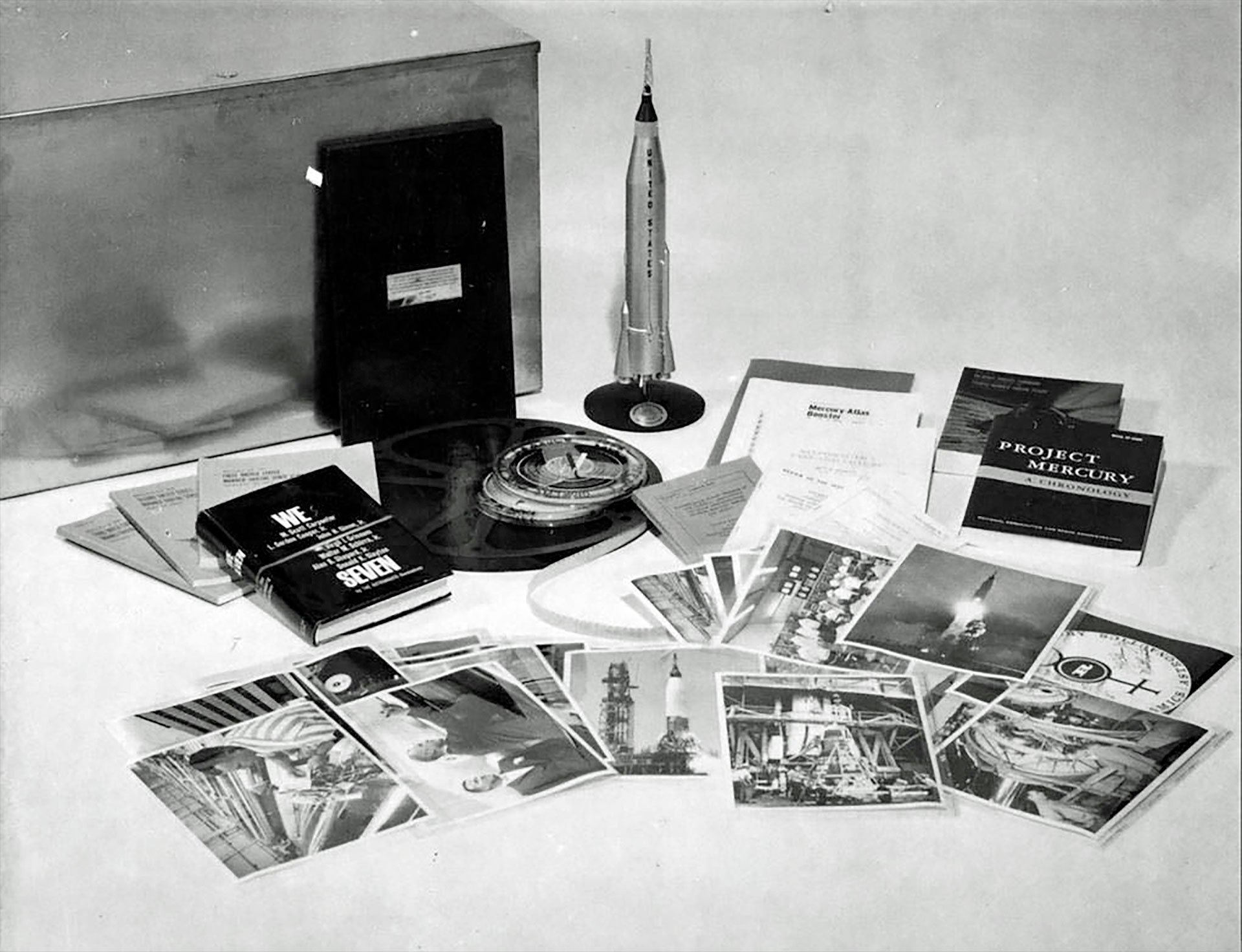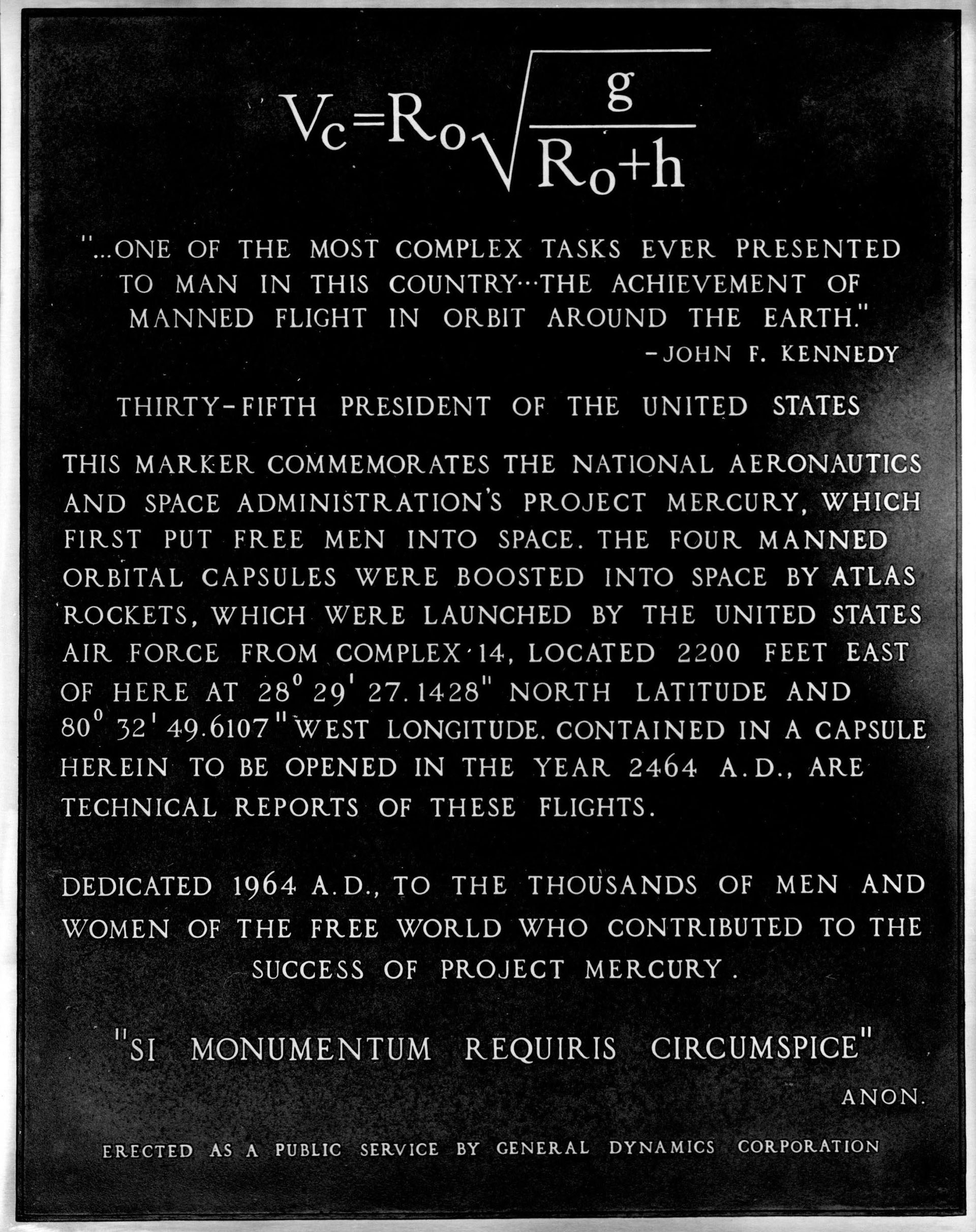A 60-year-old tribute to America’s first human spaceflight program is standing as much as the take a look at of time, however what concerning the contents of its time capsule to not be opened till 2464?
The Mission Mercury Monument situated on the Cape Canaveral launch pad from the place NASA astronauts first flew into Earth orbit was devoted on Nov. 10, 1964 “to the hundreds of women and men of the free world who contributed to the success” of america’ “pioneering man-in-space program.” The first function of the set up is a 13-foot-tall (4 meters) sculpture of the image for the planet Mercury with the quantity “7” at its middle representing the nation’s authentic seven astronauts.
The image was made by Washington Metal of Pennsylvania utilizing the identical steel alloy as the corporate developed for the Atlas rockets that launched 4 of NASA’s Mercury astronauts from Launch Advanced-14 (LC-14).
“The monument is standing up surprisingly very effectively,” stated James Draper, director of the Cape Canaveral House Power Museum, in an interview with collectSPACE.com. “The Cape Canaveral House Power Station is without doubt one of the worst preservation environments on the planet. We deal with challenges daily out right here on the museum. We’ve intense solar; the salty ocean breeze — not solely salty, however ionized; unhealthy and intense tropical storms; unique pests; and excessive humidity. All types of issues that do not bode effectively for the preservation of something.”
“I am astonished with the preservation of the Mercury monument,” stated Draper. “So no matter that metal is, it is some kind of miracle steel. I’ve inspected it pretty totally and may’t discover any energetic corrosion or rust, whereas every thing else on the Cape rots with out vital consideration.”
Associated: Mission Mercury: America’s 1st crewed area program
500 years
Encased within the monument’s concrete base is a time capsule containing technical studies, pictures, recordings and different memorabilia associated to Mission Mercury. The sealed steel field is to not be opened till 2464, 500 years after the monument’s dedication.
“I am a bit skeptical to consider there’s a lot integrity left to loads of the supplies which are in that point capsule,” stated Draper. “Now, if that field is manufactured from that very same ‘miracle’ metal, there’s a chance that issues are pretty effectively protected against the outside parts of Florida, however I’ll assure you that they aren’t protected against the inherent vice of the supplies themselves.”

“Wooden, pulp, paper supplies, movies and photographic prints are all inherently unstable items that I assure, even when they did a nitrogen swab and sealed it in order that Godzilla himself could not pry it open, the supplies inside will eat themselves up over the course of 500 years,” he stated.
The gadgets positioned contained in the time capsule had been first sealed inside “particular plastic containers,” in accordance with paperwork from Normal Dynamics, the corporate that organized and underwrote the creation of the monument. Twenty-six nonetheless pictures exhibiting highlights from the Mercury program had been “specifically ready” following the recommendation of the Eastman Kodak Firm and the American Requirements Affiliation.
Different contents included (skip forward now if you wish to be shocked in 440 years):
- Proceedings of the Mercury-Atlas Booster Reliability Workshop carried out in San Diego, California on July 12 1963;
- The outcomes of the primary, second and third crewed orbital spaceflights, as effectively an summary of all the Mercury challenge, together with the fourth orbital flight;
- James Grimwood’s “Mission Mercury: A Chronology,” revealed in 1963;
- Proceedings from a 1960 assessment of the area program held earlier than the Committee on Science and Astronautics within the Home of Representatives; a report on Mission Mercury ready by the identical committee in 1961; and a 1962 report back to the U.S. Congress on the standing of the Mercury, Gemini and Apollo packages;
- A hardcover copy of “We Seven: By the Astronauts Themselves,” revealed by Simon & Schuster in 1962;
- “Aeronautics: Previous and Future” by J.R. Dempsey, president of Normal Dynamics and a set of prophecies by “distinguished People of man’s employment in area in 2063 A.D.” as compiled for the fifth anniversary of the dedication of the Normal Dynamics/Astronautics facility in San Diego in 1963;
- One deck of Normal Dynamics “area playing cards;”
- “Friendship 7,” an hour-long coloration movie about John Glenn’s Mercury-Atlas 6 orbital spaceflight and voice countdown excerpts from every of the Mercury missions;
- A 1:sixty fifth scale desktop mannequin of a Mercury-Atlas launch car.

Different examples of every of these gadgets exist outdoors of the time capsule as effectively, with many, if not all the pictures, movies and paperwork having been scanned and archived on-line. One irreplaceable artifact, although, is rumored, however not confirmed, to even be inside.
“In keeping with a doc within the UCF [University of Central Florida] archives, ‘contents of the time capsule are stated to incorporate John Glenn’s Marine Corps pilot wings…,’ Draper advised collectSPACE. “I’ve checked out a complete bunch of different sources attempting to verify that, and to date I’ve been unable to take action. So who is aware of? It may very well be in there. It may be in fingers of the household or tucked away in a museum.”
Associated: John Glenn: America’s 1st area hero
‘Si Monumentum Requiris Circumspice’
The Cape Canaveral House Power Museum is at present accountable for the care of the monument, but additionally has help from the station’s cultural useful resource supervisor and a historian at close by Patrick House Power Base. Whereas the Mercury 7 image stays in secure situation and there’s nothing that may completed concerning the time capsule, they’re monitoring one different element of the 60-year-old set up.
“One in every of my considerations are the bronze plaques that accompany it. They’re exhibiting some surface-level patina harm,” stated Draper. “Totally different bronzes age in several kinds and it is nothing aggressive, however we have tried working with our cultural useful resource supervisor on some floor therapies.”
As the first plaque reads, the monument stands 2,200 ft (670 m) east of LC-14. On the time of its dedication 60 years in the past, the pad was within the strategy of being transformed from supporting the Atlas rockets that launched astronauts Glenn, Scott Carpenter, Wally Schirra and Gordon Cooper to getting used to launch the Atlas-Agena rockets that served as uncrewed targets for the following Gemini program missions.
LC-14 was deactivated in 1967, deserted in place in 1973 and declared a Nationwide Historic Landmark in 1984. At the moment, after seeing no launch exercise for 58 years, the pad is being ready to be used once more, this time by Stoke House, a Washington-based firm creating a reusable rocket meant to fly every day.

In contrast to one other historic marker that was situated on the base of the LC-14 launch ramp and was just lately moved into storage because of the work on the pad, there aren’t any plans to relocate the Mission Mercury Monument.
“It’s in a reasonably protected spot. There isn’t a building within the works or within the planning levels for that area that I see that might deliver the monument or its time capsule into any type of peril,” stated Draper. “If one thing like that does come up, the museum is standing by to take an energetic position in securing it, both for a transfer to a secure location, to the museum, or no matter. That could be a dialogue for one more day.”
That’s certainly lucky given the opposite intention of the Mission Mercury Monument, as famous by an inscription in Latin. Borrowed from the tomb of Sir Christopher Wren in St. Paul’s Cathedral in London, “Si Monumentum Requiris Circumspice” interprets in English to, “If you happen to search a monument, look about you.”
The quote serves as a reminder that every one of Cape Canaveral is a monument to the nation’s achievements in area, as Normal Dynamics described in 1964.

Observe collectSPACE.com on Fb and on X at @collectSPACE. Copyright 2024 collectSPACE.com. All rights reserved.





